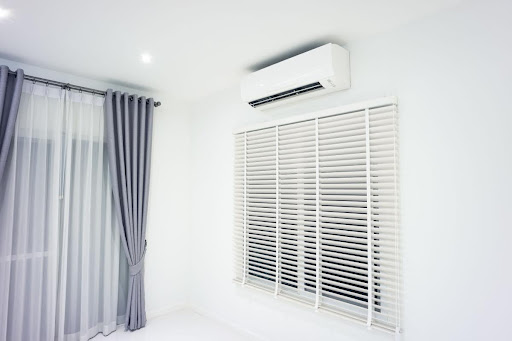Choosing the right cooling system for your home can be daunting. The debate between ductless vs. central air systems is a common fork in the road for homeowners. In this blog, we’ll review the merits and drawbacks of each system to help you make an informed decision that best suits your needs.
What Are Ductless and Central Air Systems?
Before we compare ductless vs. central air conditioning, let’s define what each system entails. A central air conditioning system, often simply called central air, utilizes a network of ducts and vents to distribute cooled air throughout your home. It typically consists of an outdoor unit containing the compressor and condenser and an indoor unit housing the evaporator coil.
On the other hand, ductless systems, also known as mini-splits, consist of an outdoor compressor unit connected to multiple indoor air handling units via small refrigerant lines. Each indoor unit can cool a separate room or zone in your home, offering a modular approach to air conditioning.
The Case for Central Air Conditioning
Central air conditioning systems are prized for their ability to cool entire homes evenly and efficiently. Here are a few reasons you might consider installing central air:
- Uniform Cooling: A central air system distributes cooled air through ducts, supplying consistent temperatures throughout your entire home.
- Aesthetic Integration: With only vents visible inside the home, traditional central air systems are less intrusive visually compared to ductless systems.
- Improved Air Quality: Central systems often come with advanced filtration that reduces airborne contaminants.
The Appeal of Ductless Air Conditioning
Ductless mini-split systems offer distinct advantages that might make them a more appealing choice for some homeowners:
- Flexibility in Cooling: Ductless systems excel in homes without existing ductwork, in new additions, or where only certain rooms need cooling.
- Energy Efficiency: Since they don’t rely on ducts, ductless systems avoid the energy losses associated with ductwork. They can be up to 30% more efficient.
- Zone Control: Each indoor unit can be controlled independently, allowing for personalized temperature settings in each room.
Comparing Installation and Costs
When considering ductless AC vs. central air, the initial cost and complexity of installation can play a major role in your decision. Installing a central air conditioner often involves significant ductwork if your home isn’t already equipped, which can be invasive and costly. In contrast, ductless systems require minimal invasive installation, with just a small hole in the wall to connect the indoor and outdoor units. This can be particularly advantageous for older homes without existing ducts or for room additions.
Energy Efficiency and Your Utility Bills
Energy efficiency is another major consideration in the discussion of ductless vs. central air conditioning. Ductless systems are often more energy efficient than traditional central AC systems. They avoid energy losses associated with ductwork, which can account for more than 30% of energy consumption, especially if the ducts are in unconditioned spaces like attics or crawl spaces. This efficiency can translate into lower utility bills and a smaller carbon footprint.
Long-Term Considerations
Over time, the advantages of each system can become more apparent. For instance, central air conditioners often require more frequent maintenance, especially if the ducts need cleaning or repair. Ductless systems, with fewer mechanical parts exposed to the elements, often have fewer issues. Additionally, you’ll want to think about each option’s average lifespan. Both systems generally offer a long service life, but the longevity can be impacted by the quality of installation and regular maintenance.
How Many Rooms Can a Ductless AC Cool?
The answer to this question will depend on the number of indoor units installed. Each unit is capable of cooling one room or zone. Therefore, you can customize a ductless mini-split system to cool as many rooms as needed, from a single room to an entire building.
Is Ductless or Central Air Better for Your Specific Needs?
To determine whether ductless vs. central air is better for your home, consider your specific needs:
- Home Layout and Size: Large homes with many rooms might benefit more from a central air system, especially if ductwork is already in place. Smaller homes, apartments, or homes without existing ducts may find ductless systems to be a more practical and less disruptive option.
- Aesthetic Considerations: Ductless units are more visible and require mounting on interior walls, which may not suit every decor style. Central air is almost invisible inside the home, with only the vents showing.
- Air Quality Concerns: Central air systems can improve indoor air quality by filtering the air circulated through the ducts. However, if not maintained properly, ducts can also harbor dust and allergens. Ductless systems typically have multi-stage filtration but don’t generally circulate air between rooms, which can reduce the spread of airborne contaminants.
Service Plus Can Help You Make the Right Decision!
Deciding between ductless vs. central air ultimately depends on your home’s structure, your cooling needs, and your budget. Evaluate both options in the context of what is most important for your comfort and your home’s efficiency.
Ready to choose the right air conditioning system for your home? Contact Service Plus for your AC installation in Indianapolis or one of the surrounding areas! Whether you’re leaning toward a ductless system or a central air setup, our team at Service Plus is here to help your home remain cool and comfortable.
We offer many services, from comprehensive installations to AC repair in Indianapolis, IN, to meet your cooling requirements. Schedule your consultation today!


